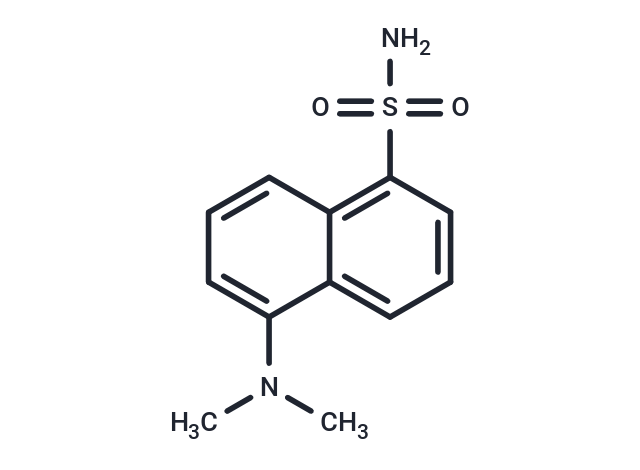Shopping Cart
Remove All Your shopping cart is currently empty
Your shopping cart is currently empty
Dansyl amide is a fluorescent dye used in biochemistry and chemistry to label substances with the fluorescent dansyl group.

| Pack Size | Price | USA Warehouse | Global Warehouse | Quantity |
|---|---|---|---|---|
| 200 mg | $33 | In Stock | In Stock | |
| 1 mL x 10 mM (in DMSO) | $29 | In Stock | In Stock |
| Description | Dansyl amide is a fluorescent dye used in biochemistry and chemistry to label substances with the fluorescent dansyl group. |
| Cell Research | Instructions I. Reagent preparation 1. Preparation of stock solution: Dissolve it in an appropriate solvent, such as dimethyl sulfoxide (DMSO) or ethanol. 2. Preparation of working solution: The typical working concentration range of Dansylamide is 10 µM to 1 mM, and the specific concentration can be adjusted according to the experimental requirements. II. Operation steps 1. Labeling process: 1) Sample preparation: Prepare the sample to be labeled, such as protein, peptide or other biomolecule. For protein labeling, it is usually necessary to use a sufficient amount of purified protein. 2) Reaction: Mix the sample with Dansylamide solution and add an appropriate buffer. The pH value of the buffer should usually be controlled at around 8.0 to optimize the labeling process. 3) Incubation: Incubate the sample at room temperature, the reaction time is usually 30 minutes to 2 hours, and the specific time can be adjusted according to the target molecule and the desired degree of labeling. 4) Termination reaction: After incubation, the reaction can be stopped by adding an appropriate terminator or diluting the sample. 2. Purification: After the labeling reaction is completed, dialysis, gel filtration and other methods can be used to remove unreacted Dansylamide to purify the labeled biomolecules. 3. Fluorescence detection: 1) Detection: Detection can be performed using a fluorescence spectrophotometer or fluorescence microscope. The excitation wavelength is set to 335 nm and the emission wavelength is set to 510 nm. The fluorescence intensity is proportional to the molecular weight of the labeled biomolecule. 2) Data analysis: According to the change in fluorescence intensity, a standard curve can be drawn, and the degree of labeling can be evaluated by comparing the sample and the control group. Notes: 1. Photostability: Dansylamide is sensitive to light, and long-term strong light exposure should be avoided during the experiment to prevent fluorescence attenuation. 2. Concentration control: Too high a labeling concentration may cause autofluorescence quenching, so the dye concentration should be optimized to avoid this. 3. Compatibility: When using with other fluorescent dyes or labeling reagents, ensure that the emission spectra of different dyes do not overlap to avoid signal interference. |
| Molecular Weight | 250.32 |
| Formula | C12H14N2O2S |
| Cas No. | 1431-39-6 |
| Smiles | CN(C)c1cccc2c(cccc12)S(N)(=O)=O |
| Relative Density. | 1.314g/cm3 |
| Color | White |
| Appearance | Solid |
| Storage | keep away from direct sunlight | Powder: -20°C for 3 years | In solvent: -80°C for 1 year | Shipping with blue ice/Shipping at ambient temperature. | |||||||||||||||||||||||||||||||||||
| Solubility Information | DMSO: 140 mg/mL (559.28 mM), Sonication is recommended. | |||||||||||||||||||||||||||||||||||
Solution Preparation Table | ||||||||||||||||||||||||||||||||||||
DMSO
| ||||||||||||||||||||||||||||||||||||
| Size | Quantity | Unit Price | Amount | Operation |
|---|

Copyright © 2015-2026 TargetMol Chemicals Inc. All Rights Reserved.